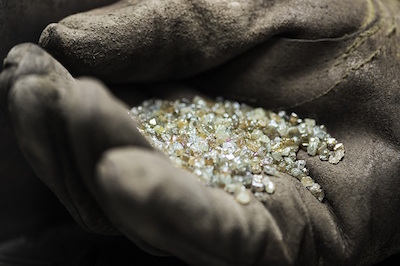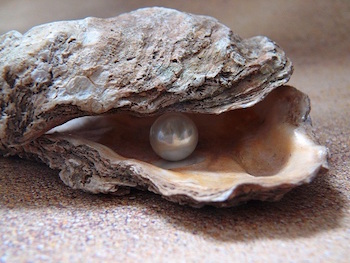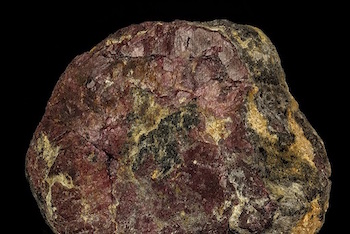 The photograph was provided courtesy of Rio Tinto Diamonds through the Smithsonian Institution, September 9, 2014.These are some of the rough diamonds donated to the National Gem and Mineral Collection of the Smithsonian Institution by Rio Tinto in 2014. “The gift [included] 500 carats of rough diamonds from Rio Tinto’s Argyle Diamond Mine in the remote northwest region of Australia,” noted a news statement from the Smithsonian Institution. “Rough diamonds consist of diamonds in their natural state after they are mined, prior to polishing. Smithsonian researchers at the National Museum of Natural History plan to study the gems, which include rare, pink diamonds, to better understand the geological history of the planet.”
The photograph was provided courtesy of Rio Tinto Diamonds through the Smithsonian Institution, September 9, 2014.These are some of the rough diamonds donated to the National Gem and Mineral Collection of the Smithsonian Institution by Rio Tinto in 2014. “The gift [included] 500 carats of rough diamonds from Rio Tinto’s Argyle Diamond Mine in the remote northwest region of Australia,” noted a news statement from the Smithsonian Institution. “Rough diamonds consist of diamonds in their natural state after they are mined, prior to polishing. Smithsonian researchers at the National Museum of Natural History plan to study the gems, which include rare, pink diamonds, to better understand the geological history of the planet.”
Mining has been an important facet of life in Grant County through the years. A local community has three streets named after gemstones not typically associated with local mining.
Bayard includes Diamond Street, Pearl Street, and Ruby Street. In addition, Diamond A Drive is located west of Tyrone.
Diamonds, pearls, and rubies are among the precious gems used in jewelry and similar works. Both diamonds and pearls come in a variety of colors, while rubies are typically red in tone. Both natural diamonds and rubies are minerals that come from the Earth, while natural pearls develop from mollusks.
Each of these gems is also a birthstone: Diamond for people born in April, Pearl for people born in June, and Ruby for people born in July.
“Diamonds typically formed more than 100 miles deep in the Earth and provide an exceptional window into the geologic processes and conditions that took place there 2–3 billion years ago,” stated Mr. Jeffrey Post, Mineralogist and Curator-in-Charge of Gems and Minerals of the National Museum of Natural History, a part of the Smithsonian Institution.
Angola, Botswana, Canada, Russia, and South Africa were among the countries that produced the most natural diamonds used as gemstones in 2016, according to the United States Geological Survey (USGS). Few diamonds are naturally produced in the United States, according to the USGS; a limited number of gem diamonds come from Arkansas annually. Some diamonds have been mined in New Mexico.
Naturally-produced diamonds are utilized for a number of purposes beyond beauty.
“Diamond may well be the world's most versatile engineering material as well as its most famous gemstone,” according to a statement from the USGS. “The superiority of diamond in so many diverse industrial applications is attributable to a unique combination of properties that cannot be matched by any other material. For example, diamond is the strongest and hardest known material and has the highest thermal conductivity of any material at room temperature. Diamond that does not meet gem-quality standards for color, clarity, size, or shape is used principally as an abrasive, and is termed ‘industrial diamond.’”
“Even though it is more expensive than competing abrasive materials, diamond has proven to be more cost effective in numerous industrial processes because it cuts faster and lasts longer than any rival material,” the statement from the USGS continued. “Synthetic industrial is superior to its natural diamond counterpart because it can be produced in unlimited quantities, and, in many cases, its properties can be tailored for specific applications. Consequently, manufactured diamond accounts for more than 90% of the industrial diamond used in the United States.” The photo was provided courtesy of moritz320 through Pixabay, August 3, 2014.A pearl is seen here in an oyster. Some pearls are natural, while other pearls are cultured.
The photo was provided courtesy of moritz320 through Pixabay, August 3, 2014.A pearl is seen here in an oyster. Some pearls are natural, while other pearls are cultured.
Pearls are “formed within a mollusk, such as an oyster, that deposits a substance called nacre around an irritant that entered the organism,” according to a statement from the USGS. “Pearl-bearing mollusks are found in both salt and fresh water. Salt-water pearls of gem quality are usually preferred for jewelry; they are produced almost entirely by the mollusk Pinctada.”
“Fresh-water pearls are produced by various clams and mussels,” the statement from the USGS continued. “Natural pearls come in various shapes: round, pear, drop, egg, and others. They also come in various colors, such as white, cream, light rose, cream rose, black, gray, bronze, blue, dark blue, blue green, red, purple, yellow, and violet.”
According to the Gemological Institute of America, “Cultured pearls are the result of the deliberate insertion of a bead or piece of tissue that the mollusk coats with nacre.” The photo was produced by Brooke Alexender of the United States Geological Survey, August 8, 2015Ruby crystals are embedded in a rock.
The photo was produced by Brooke Alexender of the United States Geological Survey, August 8, 2015Ruby crystals are embedded in a rock.
“Red corundum is called ruby,” according to a statement from the Department of Earth, Ocean and Atmospheric Sciences of The University of British Columbia. “Corundum is an aluminum oxide that commonly forms hexagonal barrel-shaped prisms that taper at both ends or as thin tabular hexagonal plates.”
Corundum was found in Georgia, Montana, and North Carolina, according to a report issued by the USGS in 1906. In a report from the USGS in 2008, global ruby production included, depending on the year, operations in Afghanistan, India, Kenya, Madagascar, Myanmar (Burma), and Vietnam, among other locales.
Do you have questions about communities in Grant County?
A street name? A building?
Your questions may be used in a future news column.
Contact Richard McDonough at chroniclesofgrantcounty@gmail.com.


